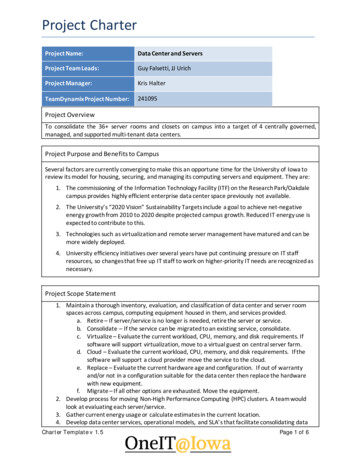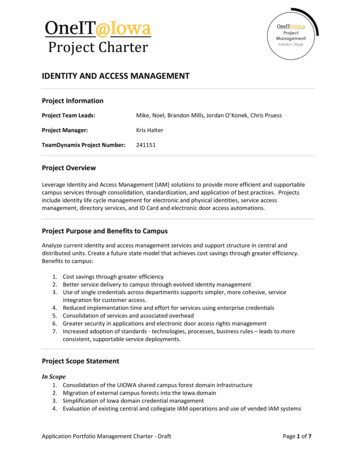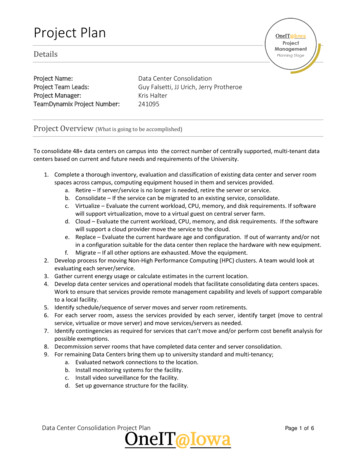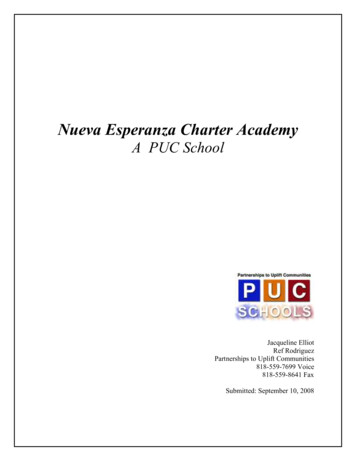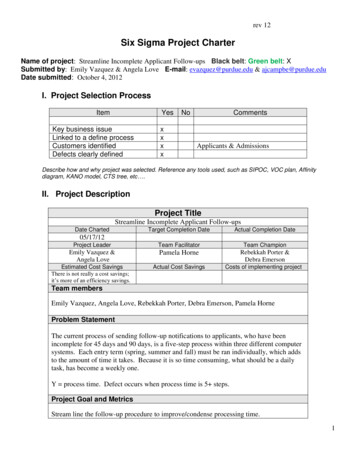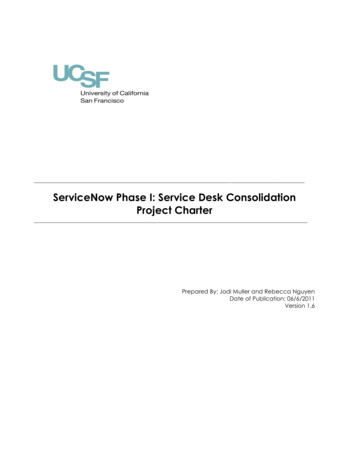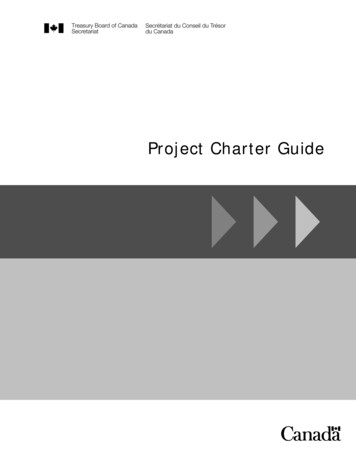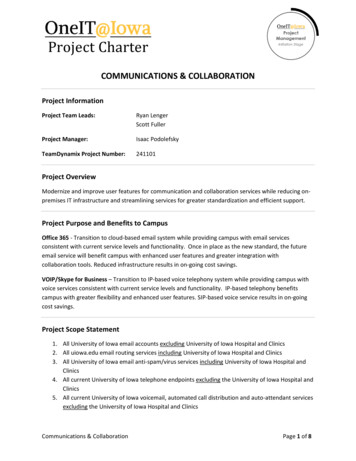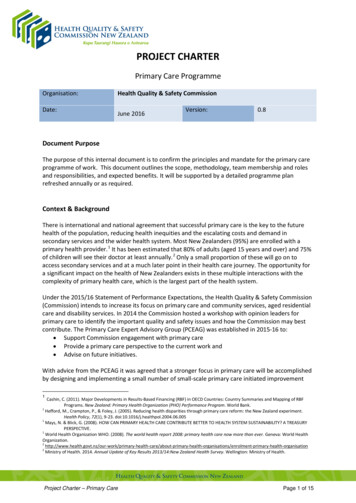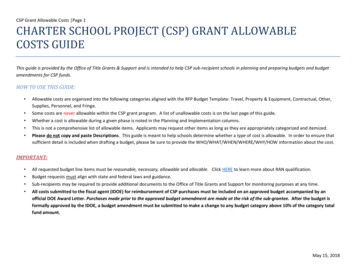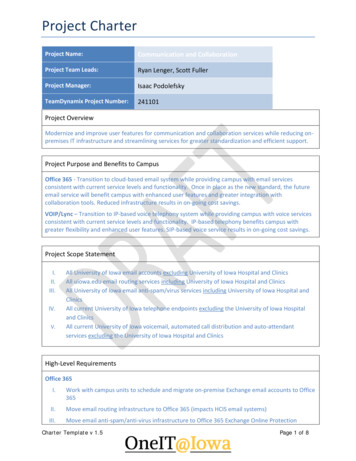
Transcription
Project CharterProject Name:Communication and CollaborationProject Team Leads:Ryan Lenger, Scott FullerProject Manager:Isaac PodolefskyTeamDynamix Project Number:241101Project OverviewModernize and improve user features for communication and collaboration services while reducing onpremises IT infrastructure and streamlining services for greater standardization and efficient support.Project Purpose and Benefits to CampusOffice 365 - Transition to cloud-based email system while providing campus with email servicesconsistent with current service levels and functionality. Once in place as the new standard, the futureemail service will benefit campus with enhanced user features and greater integration withcollaboration tools. Reduced infrastructure results in on-going cost savings.VOIP/Lync – Transition to IP-based voice telephony system while providing campus with voice servicesconsistent with current service levels and functionality. IP-based telephony benefits campus withgreater flexibility and enhanced user features. SIP-based voice service results in on-going cost savings.Project Scope StatementI.II.III.IV.V.All University of Iowa email accounts excluding University of Iowa Hospital and ClinicsAll uiowa.edu email routing services including University of Iowa Hospital and ClinicsAll University of Iowa email anti-spam/virus services including University of Iowa Hospital andClinicsAll current University of Iowa telephone endpoints excluding the University of Iowa Hospitaland ClinicsAll current University of Iowa voicemail, automated call distribution and auto-attendantservices excluding the University of Iowa Hospital and ClinicsHigh-Level RequirementsOffice 365I.Work with campus units to schedule and migrate on-premise Exchange email accounts to Office365II.Move email routing infrastructure to Office 365 (impacts HCIS email systems)III.Move email anti-spam/anti-virus infrastructure to Office 365 Exchange Online ProtectionCharter Template v 1.5Page 1 of 8
Project Charter(impacts HCIS email systems)IV.Decommission all possible on-premise Exchange, email routing and anti-spam/virus systemswhile maintaining minimum infrastructure to communicate with HCISV.Identify current non-centralized campus email systems and evaluate for migration to Office 365VI.Standardize email services for all users. On-going savings is obtained by reducing the variabilityin email servicesVII.Consolidate standalone on-premises email services to centrally provided serviceVIII.Enable hawkid@uiowa.edu email address format for all users. (first-last@uiowa.edu willcontinue for existing accounts, and each account will also receive a hawkid@uiowa.eduroutable email address. New accounts will only receive hawkid@uiowa.edu)IX.Automatically provision email mailbox for all existing and new users (current students, facultyand staff)X.Automatically de-provision email mailbox for all users upon leaving the University of Iowa(faculty and staff within 3 weeks, students 18 months after last registered semester)XI.Eliminate lifetime email routing. (Applies to former students, faculty, staff and retirees.Emeritus Faculty will continue to receive email routing)XII.No longer provide email services to retired staff. Will require adjustment of HR off-boardingprocess. (Emeritus Faculty will continue to receive email service)VOIP/LyncI.Install session border controllers (SBC) as new call control/routing solution and SIP trunktermination pointII.Purchase and install session initiation protocol (SIP) trunks for new SIP based PSTN deliveryIII.Port campus telephone numbers from analog PRI (primary rate interface) connection to newdigital SIP trunks. This is also likely to be a transition from CenturyLink to a new vendorIV.Identify replacement use cases for IP-based voice and telephony. Will require purchase of newheadsets and phones for campusV.Identify VOIP/Lync-based contact center solution to replace ACD/Auto-attendantVI.Identify and purchase smaller scale analog solutions for scenarios which cannot be converted toIP/SIPVII.Decommission or downscale existing PBX and PRI infrastructureHigh-Level RisksShared RisksI.Both Office 365 and VOIP/Lync are on-going projects with developed teams. Each project needsreview for appropriate staffing as it may be insufficient. Transitioning into OneIT format doespresent some challenges such as individual/team roles, governance and funding changesII.Office 365 email and VOIP/Lync telephone service are both services directly impacting users.Nearly every person on campus uses one, or both, of these services on a daily basis whichCharter Template v 1.5Page 2 of 8
Project Charterincreases the difficulty of making change. Communication and user training are a largecomponent of these transitionsOffice 365I.IT support and training staff resources for the increased workload during the transition to Office365 email. This is a short-term need for the duration of the projectII.Discovery of functionality gaps between old and new solutionsIII.Integration of HCIS University accounts with the Office 365 Global Address List will require HCISeffortIV.Single Sign On (SSO) for Office 365 email is configured differently from on-premises Exchange.User experience will be slightly different from current systemVOIP/LyncI.Transitioning from PRI to SIP based PSTN connections can largely be done by IT staff behind thescenes, but transitioning from PBX telephones to Microsoft Lync for voice service will requiresignificant IT staff effort for support and trainingII.Cost/Benefit analysis is difficult to determine as we’re comparing different attributes of voicecommunication. Some of the factors involved are cost avoidance for PBX upgrade,implementation cost of Lync Voice infrastructure, sunk cost of existing copper plant and PBXtelephone devices, purchase cost of Lync telephones/headsets, increased userfeatures/flexibility, increased IT support effortIII.Transitioning away from the PRI/PBX infrastructure will likely influence changes in the overallfinancial planning of the University of Iowa telephony and voice services in terms of costrecovery, common good service or some combinationAssumptions and ConstraintsOffice 365I.Current on-premises Exchange infrastructure is at end of life. Hardware is out of warranty andExchange 2010 Forefront Threat Management Gateway server (Exchange internal anti-virus) isend of life 12/31/2015. On-premises Sophos Anti-Virus software expires 4/1/2018.Infrastructure must be upgraded or replaceda. Centigram voicemail is also at end of life. Project underway to potentially replace withUnified Messaging which is a component of Exchange and must be factored in thistransition. A second option in this space is to upgrade the current Centigram voicemailsystem and postpone migration to Exchange UMb. Modern email systems provide significantly larger mailbox quotas and the new systemmust be comparable (minimum 10 GB storage per mailbox). Building on-premises willcome with cost increase over current systemc. Public and state government perceive email as a service offered to universities at nocost via cloud services. While partially true from a licensing cost perspective, theimplementation and on-going support carries different costs. Upgrades for featuressuch as Exchange UM require monthly feesCharter Template v 1.5Page 3 of 8
Project CharterII.Move all University of Iowa email accounts to Office 365 with the exclusion of current HCISemail accountsa. Leaving any email accounts on-premises requires a fixed level of infrastructure (storage,transport, client access servers) and support which detracts from savingsb. Moving email routing infrastructure to Office 365 will impact HCIS emailIII.Office 365 includes services other than email. DNA staff will need to maintain eligibility rulesalong with provisioning and de-provisioning tools for services such as OneDrive for Business,Office ProPlus, Skype for Business and YammerVOIP/LyncI.NEC PBX is nearing end of life. Maximum of 2-3 years remain without significant updatesII.Majority of current PBX telephone numbers can be ported to SIP networking and Microsoft Lynctelephone serviceIII.Advanced telephony configurations (Automatic Call Distribution systems, Boss/Adminconfigurations, Fax, Shared Lines) would remain on PBX while standard telephone connectionsare porteda. After migration of standard telephone services to Microsoft Lync Voice with SIP trunktelephone connections it will be possible to revisit advanced configurations to identifyLync/VOIP based solutionsIV.Lync Voice will be provided via computing devices with software clients such as desktopcomputers, laptops or smartphones. Existing analog desktop telephones will be removed andcomputer headsets will be purchased to replace this functionV.Moving telephone service to Microsoft Lync will reduce the need for physical move/add/changework for telephone ports on campus and shift this work to traditional IT support and virtualprovisioning and de-provisioningVI.On-campus costs for VOIP will cancel out any savings from PBX retirement. The gain ismodernization and service flexibilityProject GovernanceThe OneIT Steering Committee is ultimately responsible for overseeing and certifying the viability,support, and overall success of the Communication and Collaboration project at the Department andOrganization levels. The OneIT Steering Committee has the following responsibilities:I.Champion the Communication and Collaboration projectII.Approve the Communication and Collaboration Project CharterIII.Provide adequate staffing and resourcesIV.Provide high-level oversight, and supportV.Review and approve major scope changes to the Communication and Collaboration projectThe OneIT Program OfficeCharter Template v 1.5Page 4 of 8
Project CharterI.Champion the Communication and Collaboration projectII.Provide escalation resolutionsIII.Provide oversight of requirements, and supportIV.Provide clarification of issues, questions, and concernsThe 0ffice 365 and VOIP/Lync Advisory CommitteesI.Provide feedback and inputII.Representation of various viewpoints and departmentsIII.Validate draft procedures and policiesIV.Provide clarification of issues, questions, and concernsCampus CommunitiesI.CITL, ITADmins – Provide feedback, assist in implementationAnticipated Cost Savings CategoriesEfficiency I.Potentially consolidate non-central email systemsII.Standardized email service will reduce support costsServer Retirements –I.On-premises Exchange server reductions ( 14,000/year)II.On-premises email routing servers ( 7,000/year)Vendor Changes –I.Transition from CenturyLink PRI to Level 3 SIP Trunks ( 147,000/year)Staffing I.Email routing application admin (.25 FTE)II.Email anti-spam/virus application admin (.25 FTE)III.Email Exchange server admin (.5 FTE)IV.Email user support (.5 FTE)Licensing –I.Sophos email anti-spam/virus ( 17,500/year)Sub ProjectsOffice 365Charter Template v 1.5Page 5 of 8
Project CharterI.Migrate on-premises email services (mailboxes and routing) to Microsoft Office 365II.Evaluate HCIS impact of uiowa.edu email domain moving to Office 365III.Implement hawkid@uiowa.edu email routing as address standardIV.Exchange on-premises server upgrades (hybrid servers connecting to HCIS for comparablefederation)V.Anti-spam/virus migration to Exchange Online ProtectionVI.Integrate HCIS accounts into unified Office 365 GALVII.Automated email provisioning for students, faculty and staffVIII.Automated, graceful email de-provisioning for students, faculty and staffIX.Identify remaining devices, applications and services connecting to on-premises ExchangeLync/VOIPI.Replace legacy PBX infrastructure with VOIP-based Microsoft Lync (Session border controllers,SIP Trunks, Microsoft Lync servers)II.Review campus IP networks (wired and wireless) for increased voice and video communicationtrafficIII.Review current voice services staffing and implement proper roles for new VOIP/Lync-basedsystema. Transition from physical move/add/change physical support to IT support with virtualprovisioning/de-provisioning modelIV.Review, identify and purchase endpoint/desktop voice solutions (hard phones, headsets,cameras)V.Legacy Centigram Voicemail upgrade or replacementVI.Migration of legacy voicemail to Office 365 Exchange Unified MessagingVII.Review, identify E911 solution for Lync/VOIPVIII.Review, identify financial cost model for Lync/VOIPIX.Review, identify solutions for legacy TDM scenarios (FAX, Elevator phones, Alarms, Blue LightPhones)Preliminary MilestonesDue DateOffice 365Migrate on-premises email services (mailboxesand routing) to Microsoft Office 365Exchange on-premises server upgrades (hybridservers connecting to HCIS for comparablefederation)Charter Template v 1.51/1/20161/1/2016Page 6 of 8
Project CharterIntegrate HCIS accounts into unified Office 365GALEvaluate HCIS impact of uiowa.edu email domainmoving to Office 365Identify remaining devices, applications andservices connecting to on-premises ExchangeEmail Service Standardization1/1/201620172017a) Implement hawkid@uiowa.edu email routingas address standard2016b) Automated email provisioning for students,faculty and staff2017c) Automated, graceful email de-provisioningfor students, faculty and staff2017Identify remaining devices, applications andservices connecting to on-premises ExchangeAnti-spam/virus migration to Exchange OnlineProtectionVOIP/LyncLegacy Centigram Voicemail upgrade orreplacementReplace legacy PBX infrastructure with VOIPbased Microsoft Lync (Session border controllers,SIP Trunks, Microsoft Lync servers)Review campus IP networks (wired and wireless)for increased voice and video communicationtrafficReview current voice services staffing andimplement proper roles for new VOIP/Lync-basedsystemReview, identify and purchase endpoint/desktopvoice solutions (hard phones, headsets, cameras)Migration of legacy voicemail to Office 365Exchange Unified MessagingReview, identify E911 solution for Lync/VOIPReview, identify financial cost model forLync/VOIPReview, identify solutions for legacy TDMscenarios (FAX, Elevator phones, Alarms, BlueLight Phones)Charter Template v e 7 of 8
Project CharterProject TeamRoleRyan LengerLead, Comm & CollScott FullerLead, Comm & CollIsaac PodolefskyProject Manager, Comm & CollStakeholders:Refer to Stakeholder RegistryPotential Implementation Cost:TBD at Sub ProjectsTarget Start Date:5/1/2015Target Closeout Date:1/1/2019 MM/DD/YYCharter Ratification DateCharter Template v 1.5Page 8 of 8
Project Charter . Project Overview . . (SBC) as new call control/routing solution and SIP trunk termination point II. Purchase and install session initiation protocol (SIP) trunks for new SIP base
